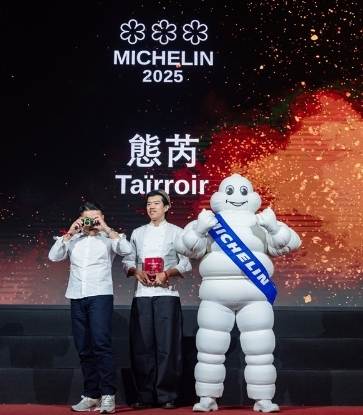For Chef Arvin Wan of MINIMAL in Taichung, the world’s first MICHELIN-Star ice cream-focused restaurant, Taiwan holds a special place on the global culinary map for its unique approach to “sweet.”
At the heart of this distinction is the island’s cultural and ecological richness. “Taiwan’s diverse population, varied climate and geography — from mountains to coastlines — bring an incredible range of ingredients and dessert styles,” says Wan. “This diversity results in a wide variety of flavours and styles.”
Taiwan’s “sweet” is bold in its presentation. “A strong emphasis on aroma is a defining trait,” he explains, referencing the smoky depth of brown sugar or the nostalgic banana essence in traditional treats. Another hallmark is the interplay between sweet and savoury, like preserved fruits or traditional pastries filled with red bean paste and pork floss, which add unexpected complexity and layers.

During a recent visit to Tokyo, Wan met Chef Mineko Kato of Green Star and One-MICHELIN-Star restaurant FARO. He was struck by their similarities in culinary perspectives and approach to design. A visionary in sustainable pastry, Kato is known for creating elegant, plant-based desserts. She works closely with producers who care deeply about the environment and tradition, often travelling to the source herself.
Inspired by their aligned philosophies, Wan invited Kato to Taiwan to explore its unique interpretations of sweetness and the vibrant stories behind its ingredients.
RELATED: What is a MICHELIN Green Star?

A Sweet Journey Down Memory Lane
Their journey began with a visit to Yi Zhong Feng Ren Ice, a nostalgic dessert shop in Taichung. Known for its simple trio of candied red beans, sour plum ice, and traditional Taiwanese ice cream, the treat is a local staple. Wan recalls living nearby as a child and often buying several cups of the “dry” version — served with extra scoops of ice cream — to enjoy slowly at home. While minimal in components, the dessert is crafted with care. Sour plums are salted and then sweetened, and red beans are cooked with two types of sugar for added depth. Founded in 1946, this beloved shop has been passed down through three generations and remains a cherished taste of home for many returning to Taichung.
RELATED: Peanut Ice Cream Roll: Sincere Charm That Goes Straight to Your Heart

Next, they visited YEN SHIN-FA COOKIES, the establishment credited with creating the modern pineapple cake, located in Dali, Taichung. Now one of Taiwan’s most iconic desserts, the pineapple cake has a cross-cultural origin. Fourth-generation owner Yen Jung-ching shared how his grandfather, after studying in Tokyo during World War II, combined the buttery texture of Western cookies, the sweet-sour punch of Taiwanese pineapple, and the precision of Japanese confectionery to create the now-familiar bite-sized treat. The dessert is a reflection of Taiwan’s layered cultural history, shaped by Chinese, Western, and Japanese influences.
RELATED: Generations of Flavor: The Mothers Behind Taiwan’s Bib Gourmand Family Recipes

In Taipei, they explored Beigang Sweet Soup, a heritage dessert shop in the Huaxi Street Night Market. Open since the 1950s, it serves traditional dishes such as boiled mochi, sweet rice porridge, and taro soup — all prepared using time-honoured methods. The mochi, for example, is handmade by grinding glutinous rice into smooth paste, dehydrating it into cakes, then cooking it to achieve a satisfyingly chewy texture.
RELATED: The Ultimate Guide in Navigating Taipei's Night Markets

Contemporary and Distinctive Takes on Sweetness
The Bib Gourmand establishment nearby, HUGH dessert dining, represents a new frontier of Taiwanese sweets. Chef Victor Cheng and co-founder Kent Ying merge classical Western techniques with local ingredients and inspirations. One standout dish layers Cointreau jelly, ponkan segments, dill cream, and fresh dill — paired with crispy kumquat chips and a kumquat-olive oil dressing, as well as a sweet soy sauce gelée and a spicy kumquat sorbet — an inventive nod to the traditional Hakka pairing of poached chicken with kumquat sauce. The result is a bold, contemporary take on what “Taiwanese sweetness” can be.

Travelling south, the duo headed to Master Zhang Brown Sugar in Nanhua, Tainan, to experience the traditional craft of wood-fired brown sugar making. Brown sugar is one of the often-used ingredients in Taiwan, found in everything from bubble tea to desserts and even savoury dishes like braised pork. Master Zhang Brown Sugar keeps the traditional hand-made method, using sugarcane grown without herbicides or pesticides in clean soil. The result is a rich, earthy sweetness that tells the story of its land, distinctive and irreplaceable.
RELATED: 24 Hours in Tainan: A Classic Day Tour of Best Small Eats

Back at the MINIMAL kitchen, the chefs each created a dessert inspired by their journey. Wan crafted a dish based on his childhood memories of Yi Zhong Feng Ren Ice, using rice-scented gelato paired with jasmine and burdock sauce, and local vegetable crisps.

Kato, on the other hand, presented a plant-based dessert featuring Taiwanese chocolate ice cream, paired with agar jelly made from local black tea, and a brown sugar-infused cream. Together, their creations showcase Taiwan’s evolving dessert culture, blending tradition and innovation, depth and delicacy.
RELATED: Innovation and Diversity: The Faces of Vegetarian Cuisine in Taiwan



















